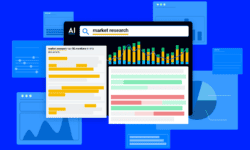What drives business leaders most critical decisions?
Data.
But the leader with the best data, or the most data, doesn’t automatically win. What matters is the ability to uncover the most relevant information efficiently. The impact of efficiently uncovering data-driven insights can’t be overstated. It’s the difference between deals won or lost; products launched or missed; new segments penetrated or not; and of course, competitive advantage.
With the amount of text-based data growing exponentially every day, leaders are struggling to keep up. Advancements in AI are making it possible for organizations to augment human research efforts and have better ongoing knowledge of the ever-increasing volume of information available.
As technology accelerates, organizations must keep pace. According to Gartner, 85 percent of CIOs “will be piloting AI programs through a combination of buy, build, and outsource efforts” by 2020.
In short, AI will soon touch every business and industry in the world, and an early investment is essential.
Why early adoption of AI matters
Adopting new tech early comes with high risk – but might also establish a company as a leader in their field. Put simply, early adoption of new technologies drives better business outcomes.
Revenue and optimized market positioning are among the advantages of organizations adopting technologies like AI before their peers. There is still reluctance, particularly in public companies that are known to take a more cautious approach, usually falling into the “Late Majority” or even “Laggard” category of adoption.
Of course, much reluctance has to do with financial implication. Executives are wary of spending millions with an unclear ROI. But moving from a cautious approach to software, to a pioneering one, can have real payoffs. Luckily, augmented intelligence offers ROI in the form of saved time, increased efficiency across the enterprise, and fewer opportunities missed.
Early investment in the right tools gives you time to build a solid foundation, experiment, and quickly implement new changes or processes as technology progresses. Conscientious team development can also foster a more collaborative workplace culture that’s prepared to conquer the trials and errors of digital transformation, especially as AI becomes more ingrained across a wider scope of business practices. With the help of AI, data can be shared, stored, searched, and organized to eliminate redundancies across departments, ultimately uniting your organization under common goals to drive business growth.
How Augmented Intelligence transforms workflows
Augmented intelligence is a type of AI that facilitates the work of highly trained professionals. It means overcoming the human limitations that hinder effective research. This AI layer complements knowledge workers’ efforts and allows them to essentially automate or drastically reduce the time devoted to low-value tasks, while focusing more on higher impact issues.
Related: Boosting Productivity For Knowledge Workers With Augmented Intelligence
One of the advantages of machine learning is its ability to process huge quantities of data in a matter of seconds — something that goes beyond the scope of human ability. Natural language processing (NLP) adds a layer of textual analysis, allowing search within precise contextual constraints. In turn, knowledge workers receive a finely-curated set of insights, tailored to make the most impact towards the immediate task at hand. Further enhanced by relevance algorithms, this AI-driven approach results in comprehensive research. It also ensures that no team of human analysts is left using CTRL-F to search through piles of documentation to find data of potential value.
When the right data is delivered at the right time, management becomes more informed, more secure, and more confident in their ability to make strategic decisions without fear of missing out on details that may be buried deep within a report, or hidden in the fine print. When your team has a finger on the pulse of your industry, it’s easier to take the calculated risks you need to stay ahead of the competition.
Augmented Intelligence can eliminate time-consuming tasks, freeing up teams to focus on higher value analysis
Actionable decision-making may be supplemented by the advantages AI can bring, but ideation still falls on the shoulders of your business intelligence team. AI alleviates the tedious busy work, but a human touch completes the circle — transforming raw information into tangible plans and processes, and igniting innovation.
When humans partner with machines, it opens up new possibilities for organizations to focus more time on meaningful projects, like developing product, building brand, or elevating customer experience. It’s these innately human actions, powered by AI, that propel emerging leaders of the pack into true industry trailblazers.
Humans and AI work best in tandem
AI isn’t going anywhere, and humans and AI work best in tandem. The right blend of tech and teams can help you stay ahead of the curve, deliver new insights for competitive advantage, and keep up with the pace of innovation.




